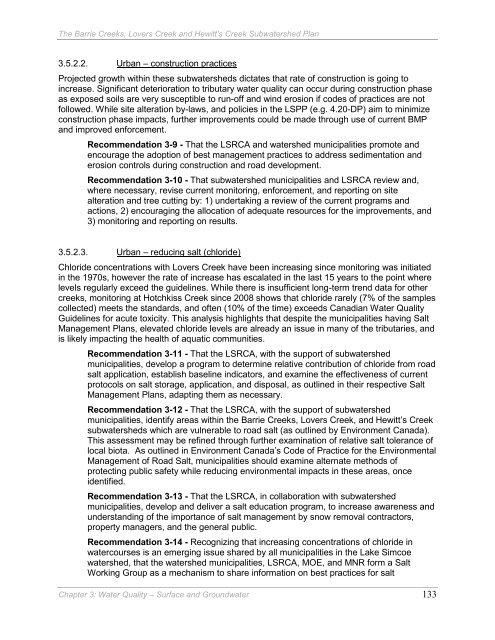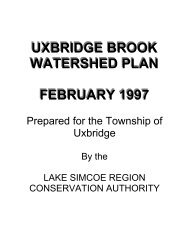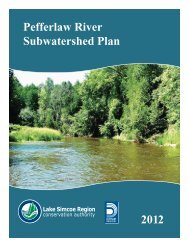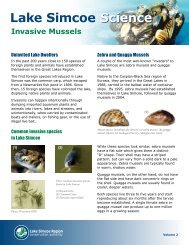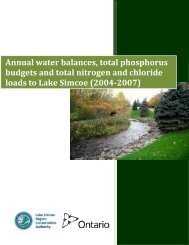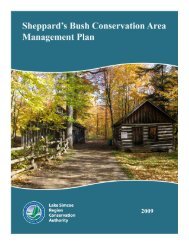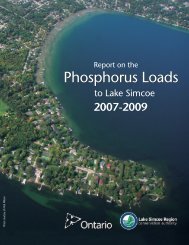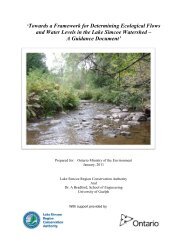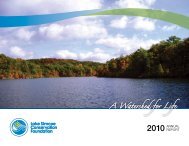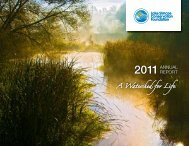Barrie Creeks, Lovers Creek, and Hewitt's Creek Subwatershed Plan
Barrie Creeks, Lovers Creek, and Hewitt's Creek Subwatershed Plan
Barrie Creeks, Lovers Creek, and Hewitt's Creek Subwatershed Plan
Create successful ePaper yourself
Turn your PDF publications into a flip-book with our unique Google optimized e-Paper software.
The <strong>Barrie</strong> <strong><strong>Creek</strong>s</strong>, <strong>Lovers</strong> <strong>Creek</strong> <strong>and</strong> Hewitt’s <strong>Creek</strong> <strong>Subwatershed</strong> <strong>Plan</strong><br />
3.5.2.2.<br />
Urban – construction practices<br />
Projected growth within these subwatersheds dictates that rate of construction is going to<br />
increase. Significant deterioration to tributary water quality can occur during construction phase<br />
as exposed soils are very susceptible to run-off <strong>and</strong> wind erosion if codes of practices are not<br />
followed. While site alteration by-laws, <strong>and</strong> policies in the LSPP (e.g. 4.20-DP) aim to minimize<br />
construction phase impacts, further improvements could be made through use of current BMP<br />
<strong>and</strong> improved enforcement.<br />
Recommendation 3-9 - That the LSRCA <strong>and</strong> watershed municipalities promote <strong>and</strong><br />
encourage the adoption of best management practices to address sedimentation <strong>and</strong><br />
erosion controls during construction <strong>and</strong> road development.<br />
Recommendation 3-10 - That subwatershed municipalities <strong>and</strong> LSRCA review <strong>and</strong>,<br />
where necessary, revise current monitoring, enforcement, <strong>and</strong> reporting on site<br />
alteration <strong>and</strong> tree cutting by: 1) undertaking a review of the current programs <strong>and</strong><br />
actions, 2) encouraging the allocation of adequate resources for the improvements, <strong>and</strong><br />
3) monitoring <strong>and</strong> reporting on results.<br />
3.5.2.3.<br />
Urban – reducing salt (chloride)<br />
Chloride concentrations with <strong>Lovers</strong> <strong>Creek</strong> have been increasing since monitoring was initiated<br />
in the 1970s, however the rate of increase has escalated in the last 15 years to the point where<br />
levels regularly exceed the guidelines. While there is insufficient long-term trend data for other<br />
creeks, monitoring at Hotchkiss <strong>Creek</strong> since 2008 shows that chloride rarely (7% of the samples<br />
collected) meets the st<strong>and</strong>ards, <strong>and</strong> often (10% of the time) exceeds Canadian Water Quality<br />
Guidelines for acute toxicity. This analysis highlights that despite the municipalities having Salt<br />
Management <strong>Plan</strong>s, elevated chloride levels are already an issue in many of the tributaries, <strong>and</strong><br />
is likely impacting the health of aquatic communities.<br />
Recommendation 3-11 - That the LSRCA, with the support of subwatershed<br />
municipalities, develop a program to determine relative contribution of chloride from road<br />
salt application, establish baseline indicators, <strong>and</strong> examine the effectiveness of current<br />
protocols on salt storage, application, <strong>and</strong> disposal, as outlined in their respective Salt<br />
Management <strong>Plan</strong>s, adapting them as necessary.<br />
Recommendation 3-12 - That the LSRCA, with the support of subwatershed<br />
municipalities, identify areas within the <strong>Barrie</strong> <strong><strong>Creek</strong>s</strong>, <strong>Lovers</strong> <strong>Creek</strong>, <strong>and</strong> Hewitt’s <strong>Creek</strong><br />
subwatersheds which are vulnerable to road salt (as outlined by Environment Canada).<br />
This assessment may be refined through further examination of relative salt tolerance of<br />
local biota. As outlined in Environment Canada’s Code of Practice for the Environmental<br />
Management of Road Salt, municipalities should examine alternate methods of<br />
protecting public safety while reducing environmental impacts in these areas, once<br />
identified.<br />
Recommendation 3-13 - That the LSRCA, in collaboration with subwatershed<br />
municipalities, develop <strong>and</strong> deliver a salt education program, to increase awareness <strong>and</strong><br />
underst<strong>and</strong>ing of the importance of salt management by snow removal contractors,<br />
property managers, <strong>and</strong> the general public.<br />
Recommendation 3-14 - Recognizing that increasing concentrations of chloride in<br />
watercourses is an emerging issue shared by all municipalities in the Lake Simcoe<br />
watershed, that the watershed municipalities, LSRCA, MOE, <strong>and</strong> MNR form a Salt<br />
Working Group as a mechanism to share information on best practices for salt<br />
Chapter 3: Water Quality – Surface <strong>and</strong> Groundwater 133


